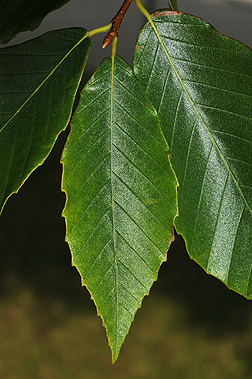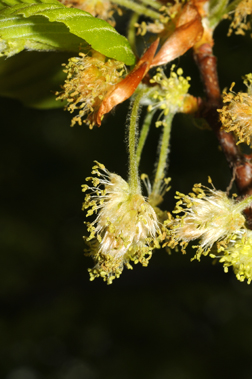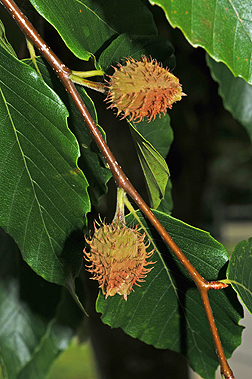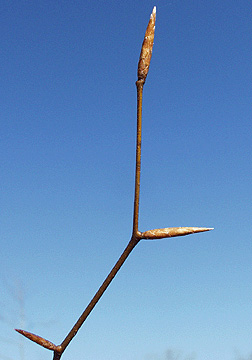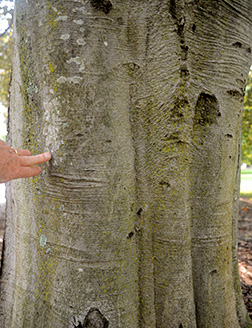 Virginia Tech Dendrology
Virginia Tech Dendrology
American beech Fagaceae Fagus
grandifolia Ehrh.
![]()
![]()
![]() symbol: FAGR
symbol: FAGR
Leaf: Alternate, simple, elliptical to oblong-ovate, 2 1/2 to 5 1/2 inches long, pinnately-veined, 11-14 pairs of veins, with each vein ending in a sharp distinct tooth, shiny green above, very waxy and smooth, slightly paler below.
Flower: Species is monoecious; male flowers borne on globose heads hanging from a slender 1 inch stalk, female flowers borne on shorter spikes, appearing just after leaves in the spring.
Fruit: Nuts are irregularly triangular, shiny brown and edible, found in pairs within a woody husk covered with spines, 1/2 to 3/4 inch long, maturing in the fall.
Twig: Very slender, zigzag, light brown in color; buds are long (3/4 inch), light brown, and slender, covered with overlapping scales (best described as "cigar-shaped"), widely divergent from the stems, almost looking like long thorns.
Bark: The bark is smooth, thin, and gray in color even on the largest stems. Beech bark diseases severely deforms the smooth bark.
Form: A medium to large tree up to 100 feet tall with a rounded crown. Often found in thickets produced by root suckering. Old trees may be surrounded by a ring of young beech.
Looks like: European beech
- downy serviceberry
- American chestnut
- sawtooth oak
Additional Range Information: Fagus grandifolia is native to North America. Range may be expanded by planting. Download the full-size PDF map.
More Information: Fall Color - Wood
External Links: USDAFS Silvics of North America - USDAFS FEIS Silvics - USDA Plants Database - Horticulture Information - USDAFS Forest Products Lab
All material 2025 Virginia Tech Dept. of Forest Resources and Environmental Conservation; Photos and text by: John Seiler, Edward Jensen, Alex Niemiera, and John Peterson; Silvics reprinted from Ag Handbook 654; range map source information
